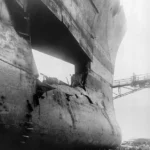On November 15, 1988, the Soviet space program achieved a remarkable milestone. The Buran, the USSR’s answer to NASA’s Space Shuttle, took to the skies for its maiden flight. This historic event marked both the beginning and end of the Buran program.
The Buran’s first and only flight lasted 206 minutes, orbiting Earth twice before landing successfully at Baikonur Cosmodrome. Unlike its American counterpart, the Soviet shuttle flew completely unmanned, controlled by onboard computers. This technological feat demonstrated the advanced capabilities of Soviet aerospace engineering.
The Buran’s flight represented the culmination of years of development and billions of rubles invested. Despite its successful mission, changing political and economic realities in the Soviet Union led to the program’s cancellation shortly after. The Buran never flew again, becoming a symbol of both Soviet space ambitions and their ultimate unfulfillment.
The Buran Program
The Buran Program was the Soviet Union’s ambitious attempt to develop a reusable space shuttle system. It aimed to match and surpass NASA’s Space Shuttle capabilities during the Cold War space race.
Origins and Goals
The Buran Program began in 1974 as a response to the United States’ Space Shuttle program. Soviet leaders feared the potential military applications of the American shuttle and sought to create their own counterpart.
The primary goals were to develop a reusable spacecraft for both civilian and military purposes. This included satellite deployment, space station servicing, and potential military missions.
Soviet officials also aimed to demonstrate their technological prowess and maintain parity with the United States in space exploration.
Design and Capabilities
The Buran orbiter closely resembled NASA’s Space Shuttle in appearance, but featured significant differences in its design and operation.
Unlike the American shuttle, Buran lacked main engines. Instead, it relied on the powerful Energia rocket for launch. This design choice allowed for a higher payload capacity.
Key features of the Buran orbiter:
- Length: 36.37 meters
- Wingspan: 23.92 meters
- Maximum payload: 30,000 kg to low Earth orbit
- Crew capacity: Up to 10 cosmonauts
Buran was equipped with an advanced autopilot system, enabling it to perform its entire flight, including landing, without human intervention. This capability was demonstrated during its sole flight in 1988.
Historical Context
The Buran shuttle program emerged during a pivotal period of space exploration and geopolitical tension between the United States and Soviet Union. Its development and sole flight took place against the backdrop of the Cold War space race and in response to NASA’s Space Shuttle program.
Cold War Space Race
The Soviet Union initiated the Buran program in 1974 as a direct response to the U.S. Space Shuttle. Soviet leaders feared the shuttle could be used for military purposes and wanted to match American capabilities.
The program faced numerous challenges, including economic constraints and technological hurdles. Despite these obstacles, Soviet engineers made significant progress throughout the 1980s.
By 1988, the Buran was ready for its maiden flight. This achievement came at a time when the Cold War was beginning to thaw, but space remained a key arena of superpower competition.
Comparison with the NASA Space Shuttle
While visually similar, the Buran and NASA’s Space Shuttle had several key differences. The Buran was designed to be capable of fully automated flight, a feature not present in its American counterpart.
The Soviet shuttle also used a different propulsion system. Unlike NASA’s shuttle, which had its own main engines, the Buran relied entirely on its Energia rocket for launch.
Buran’s payload capacity was slightly higher than the NASA shuttle. However, it lacked the sophisticated thermal protection system of the American vehicle.
Despite these advancements, Buran flew only once. In contrast, NASA’s shuttle program operated for three decades, completing 135 missions before retirement in 2011.
Buran’s First Flight
On November 15, 1988, the Soviet space shuttle Buran embarked on its maiden and only orbital flight. The unmanned mission demonstrated the spacecraft’s capabilities and autonomous landing systems.
Mission Objectives
Buran’s inaugural flight aimed to validate the shuttle’s design and performance. Key objectives included:
• Launching successfully atop the Energia rocket • Achieving a stable orbit around Earth • Testing onboard systems and thermal protection • Executing a precise automated landing
The mission was planned to last 206 minutes from liftoff to touchdown. Engineers sought to evaluate Buran’s ability to withstand the extreme conditions of spaceflight and atmospheric reentry.
Flight Performance
Buran lifted off at 03:00 UTC from Baikonur Cosmodrome. The Energia rocket performed flawlessly, inserting the orbiter into its intended trajectory. Buran completed two orbits of Earth over 3 hours and 25 minutes.
At 06:24 UTC, Buran began its deorbit burn. The orbiter executed a series of banking maneuvers during reentry to bleed off speed. At 06:24:42 UTC, Buran touched down precisely on the runway at Baikonur, coming to a stop just 3 meters off the centerline.
The fully automated landing was a significant technological achievement. Buran’s flight systems compensated for crosswinds of 61.2 km/h (38 mph), demonstrating remarkable precision for an unpiloted craft.
Technological Innovations
The Buran spacecraft incorporated several cutting-edge technologies that set it apart from other space vehicles of its time. These advancements showcased Soviet engineering prowess and pushed the boundaries of space exploration capabilities.
Automation and Robotics
The Buran’s automated flight control system was a remarkable achievement. It allowed the spacecraft to complete its entire mission without human intervention. This system managed all aspects of the flight, from launch to landing.
The onboard computers processed data from numerous sensors, making real-time adjustments to the spacecraft’s trajectory and systems. This level of automation was unprecedented for its time, especially considering the complexity of orbital flight and atmospheric reentry.
Buran’s robotic arm, similar to the Canadarm on the U.S. Space Shuttle, enhanced its payload handling capabilities. This manipulator could deploy and retrieve satellites, as well as assist with space station docking procedures.
Thermal Protection System
Buran’s thermal protection system was crucial for surviving the extreme temperatures of atmospheric reentry. Soviet engineers developed a unique solution to this challenge.
The spacecraft’s surface was covered with approximately 39,000 tiles, each individually shaped and sized. These tiles were made of a lightweight, heat-resistant material capable of withstanding temperatures up to 1,600°C.
Unlike the U.S. Space Shuttle, Buran used a black colored thermal protection coating. This choice improved the spacecraft’s ability to radiate heat during reentry.
The tiles were bonded directly to the aluminum airframe, eliminating the need for additional insulation layers. This design choice reduced the overall weight of the spacecraft, improving its payload capacity.
Program Challenges and Setbacks
The Buran program faced significant obstacles that ultimately led to its premature termination. Financial difficulties and political turmoil during the late 1980s and early 1990s severely impacted the project’s progress and viability.
Financial Constraints
The Buran program’s enormous costs strained the Soviet Union’s economy. Estimates place the total expenditure at around 16 billion rubles, equivalent to billions of dollars. This massive investment became increasingly difficult to justify as the country’s economic situation deteriorated.
The program’s complexity and ambitious goals required substantial ongoing funding. Maintenance of specialized facilities, continued research and development, and personnel costs added to the financial burden. As resources dwindled, crucial aspects of the program suffered, including testing and safety measures.
Budget cuts forced delays and compromises. The reduction in funding slowed production schedules and limited the number of planned orbital vehicles. This financial squeeze ultimately contributed to the program’s inability to achieve its full potential.
Political Issues
The collapse of the Soviet Union in 1991 dealt a fatal blow to the Buran program. The political upheaval and shift in priorities left little room for an expensive space project with unclear immediate benefits.
Leadership changes brought new perspectives on space exploration and defense spending. Many officials questioned the need for a shuttle program, especially given the success of traditional rocket launches. The program lost its political champions and struggled to maintain relevance in the new geopolitical landscape.
Shifting alliances and the end of the Cold War reduced the perceived need for a Soviet shuttle to compete with the American space program. This loss of prestige and strategic importance further eroded support for Buran among decision-makers.
The End of Buran
The Buran program came to an abrupt halt in the early 1990s, marking the end of the Soviet space shuttle era. Economic and political factors played a key role in its cancellation, while its brief existence left a lasting impact on space exploration.
Cancellation Reasons
The collapse of the Soviet Union in 1991 dealt a fatal blow to the Buran program. Severe economic difficulties made it impossible to sustain the costly project. Funding for space exploration was drastically reduced as the new Russian government prioritized other sectors.
Technical challenges and changing priorities also contributed to Buran’s demise. The program’s high operational costs and lack of clear mission objectives made it difficult to justify its continuation. Additionally, the emergence of alternative space technologies and launch systems rendered the shuttle concept less appealing.
Legacy and Influence
Despite its short lifespan, Buran left a significant mark on space history. The program demonstrated Soviet technological capabilities and advanced aerospace engineering. Many innovations developed for Buran found applications in other areas of space exploration and aviation.
Buran’s automatic landing system was particularly noteworthy, showcasing advanced autonomous flight capabilities. This technology influenced future spacecraft designs and autonomous systems. The program also contributed to materials science, with heat-resistant tiles and other materials finding uses beyond space applications.
Today, Buran serves as a reminder of the ambitious space race era. Its sole flight remains a unique achievement in spaceflight history, highlighting both the potential and challenges of reusable spacecraft development.
Reflections on the Single Flight
The Buran’s lone flight demonstrated both impressive technological achievements and unrealized potential. Its automated landing was particularly noteworthy.
Successes Achieved
Buran’s unmanned orbital flight lasted 3 hours and 25 minutes. The spacecraft completed two Earth orbits and executed a precise automated landing at the Baikonur Cosmodrome. This landing was a significant technical feat, as no spacecraft had ever performed an unmanned landing from orbit before.
The flight proved the viability of the Buran’s design and systems. It withstood the rigors of launch, orbit, reentry, and landing without major issues. The successful automated landing also demonstrated advanced control systems and software capabilities.
Potential Untapped
Despite its successful maiden flight, Buran never flew again. The program’s cancellation left many of its capabilities unexplored. Buran was designed to carry up to 30 tons of payload to orbit and return with 20 tons.
The spacecraft could have supported a crew of up to 10 cosmonauts for 30-day missions. Its potential roles included satellite deployment, space station resupply, and even interplanetary missions when paired with a planned booster stage.
Buran’s reusability and versatility could have significantly advanced Soviet space capabilities had the program continued. Its cancellation left these possibilities unrealized.
References
- Russian Space Web (n.d.) – Buran: The Soviet Space Shuttle Program Link
- NASA History (n.d.) – Comparison of the Buran and NASA’s Space Shuttle Link
- Roscosmos Archives (n.d.) – Buran’s First and Only Flight Link
- Imperial War Museum (n.d.) – The Cold War Space Race Link
- BBC Future (2020) – The Forgotten Soviet Space Shuttle That Beat NASA’s Technology Link
- Smithsonian Air & Space Museum (n.d.) – The Buran and Its Legacy Link




